Microsoft Surface Pro 3 Review
by Anand Lal Shimpi on June 23, 2014 3:55 AM ESTBattery Life
Microsoft made no sacrifice in battery capacity in pursuit of Surface Pro 3's thin chassis design. The new tablet features an integrated 42Wh battery just like the previous two models. Charging duties are handled by an external 31W charger with a brand new magnetic connector. Microsoft never seemed to get a good MagSafe clone working in the previous models, so Surface Pro 3 abandons the previous design entirely in favor of something a bit more sensible.
The new connector no longer looks like an oversized MagSafe connector, and instead features a thin plastic insert that mates with the charge port on Surface Pro 3. Charge time hasn't changed, you can fully charge the device in around 2.62 hours:
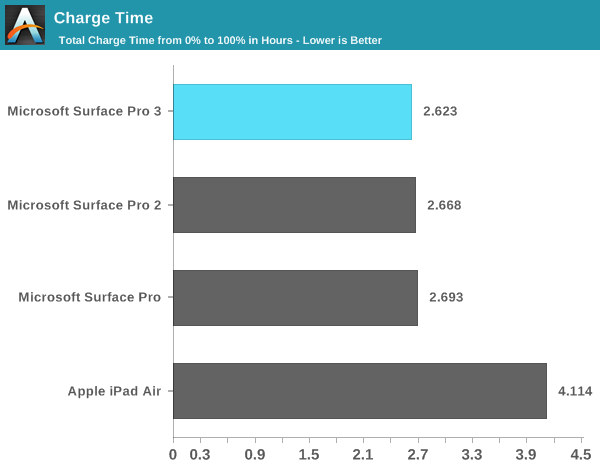
The device-side connector features 40 pins but you only need 12 of them to charge the device. The remaining pins are used for Gigabit Ethernet, USB, DisplayPort (up to 4096 x 2304) and audio. Microsoft seems hell bent on avoiding Thunderbolt at all costs so instead of embracing the standard it has created a custom alternative of its own doing. The benefit to Microsoft's connector is it can obviously deliver more power than Thunderbolt can, the downside is that it can't send PCIe and thus you don't get support for any ultra high bandwidth external storage devices. I still would rather see Microsoft implement Thunderbolt as there's at least an existing ecosystem built around that but here we are three generations into Surface and if we haven't seen it by now I don't think we're ever going to.
The supplied power adapter includes a USB charge port capable of delivering 1A at 5V.
As Surface Pro 3 is designed to be both a laptop and a tablet I've run it through both our Windows laptop battery life tests and our tablet battery life tests.
Laptop Battery Life
As a laptop, Surface Pro 3 delivers comparable battery life to other optimized Haswell ULT designs. I threw in Sony's Vaio Pro 13 into the mix because it has a similar sized battery (37Wh vs. 42Wh) and is one of the most power efficient Windows Ultrabook platforms on the market. Surface Pro 3 manages to deliver similar battery life, which means it's a little less power efficient but the two are within the same range at least.
Compared to Surface Pro 1 and 2, Surface Pro 3 at worst delivers similar battery life and at best increases range on a single charge by up to 20%. We're looking at 3.75 hours - 7.6 hours of notebook usage on a single charge depending on usage.
It's worth noting that there's a substantial advantage in battery life if we look at the 13-inch MacBook Air running OS X. I only mention this because of Microsoft's insistence on comparing Surface Pro 3 to Apple's popular line of notebooks.
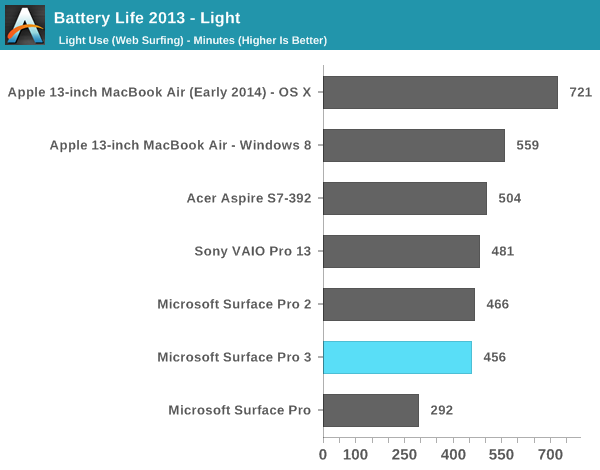

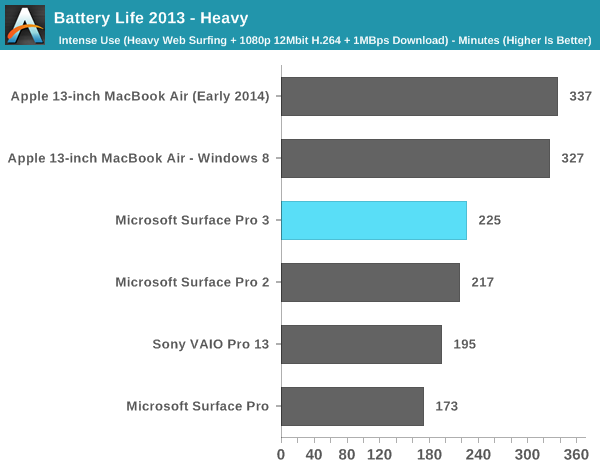
Tablet Battery Life
Tablet workloads are going to be far more display power bound than anything else. Here we see 7.58 - 8.03 hours of continuous usage, a slight regression compared to Surface Pro 2. Video playback remains more power hungry than web browsing, which is something I've noted in previous tablet-evaluations of Intel's Core silicon. I don't believe Intel's Core processors are very optimized for video decode power consumption. If anything is going to change with the move to Broadwell and Core M I suspect video decode power may be it.
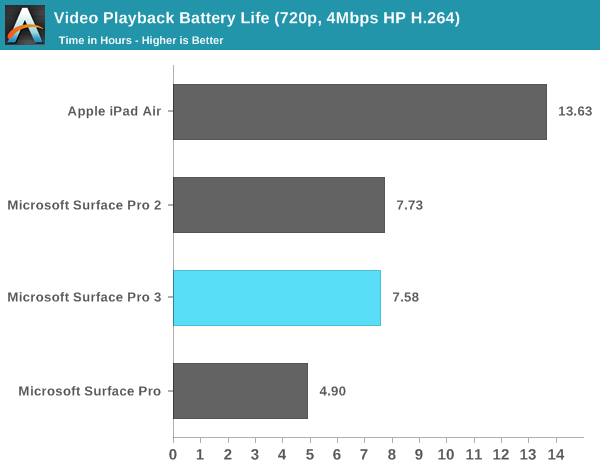
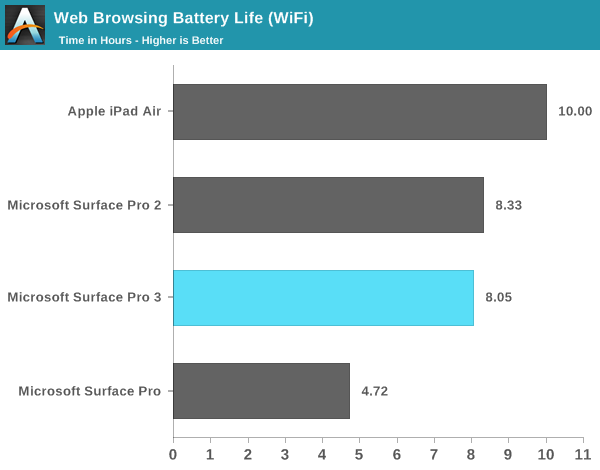


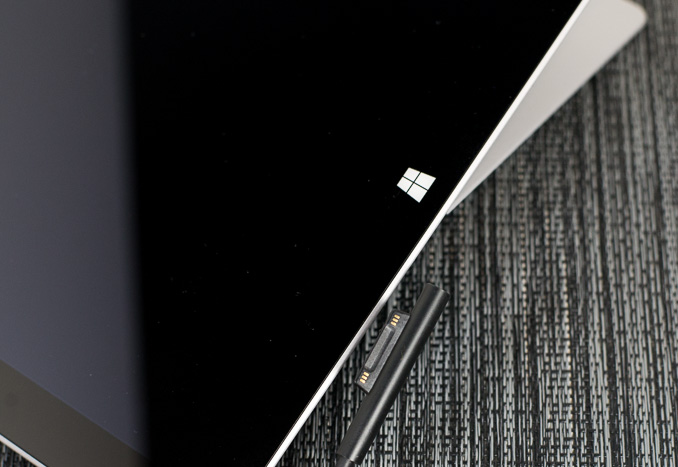
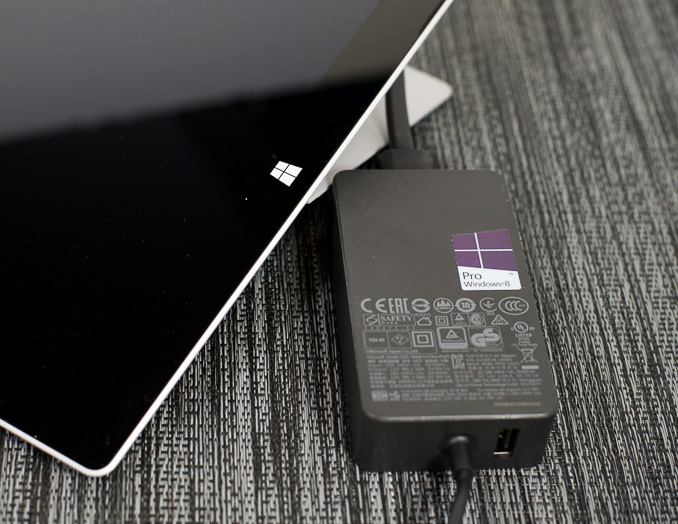








274 Comments
View All Comments
fella1 - Monday, June 23, 2014 - link
I use mine to read comics and graphic novels and the fan does not come on when for this activity. The screen really is the perfect size for it to.Tikcus9666 - Monday, June 23, 2014 - link
A regression in performance from SP2 to SP3 in intensive workloads, has made me wait on ordering the i7 version until this is reviewedIf the thermal limit is reached more quickly than the SP2, it may be a better buy (SP2) for me than an i7 pro 3 if under intensive workloads the i7 in the Pro 3 performs worse than the previous i5 in the SP2
Hrel - Monday, June 23, 2014 - link
"given the substantial reduction in device thickness (and thus improvement in usability)"wat? Thinner doesn't make it easier to use... in any way shape or form. It's purely aesthetic.
ymcpa - Monday, June 23, 2014 - link
There is a reduction in thickness and a reduction in weight. Plus the even weight distribution makes the device easier to hold. Go to a store and try it out.drunken - Monday, June 23, 2014 - link
agree - it's not perfect as a tablet but the thinness makes it easier to useben.avellone - Monday, June 23, 2014 - link
Great review! Glad to see the display size has increased, my SP2 feels a little cramped at times - such as when writing notes. Too bad gaming performance had to take such a hit in this iteration, but such are the realities of engineering design tradeoffs :/MarkieGcolor - Monday, June 23, 2014 - link
What a stupid piece of junk this thing isGunbuster - Monday, June 23, 2014 - link
How insightful, tell us more.Razzy76 - Monday, June 23, 2014 - link
I'd rather have this piece of junk than the piece of sh*t iPad and MacBook Air/Pro.OneOfTheseDays - Monday, June 23, 2014 - link
I own the SP2 but skimped on this generation. I'm waiting for Broadwell, when they can really make this design sing with great battery life and less heat.Further, Windows9 is going to be a massive improvement in usability for hybrid devices.